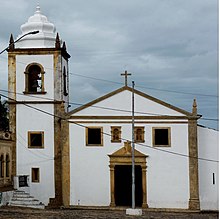Church of Saints Cosme and Damião
| Church of Saints Cosme and Damião | |
|---|---|
| Igreja Matriz de São Cosme e São Damião | |
 |
|
| Basic information | |
| Geographic coordinates | 7°50′03″S 34°54′23″W / 7.8340745°S 34.9063078°W |
| Affiliation | Catholic |
| Rite | Roman Rite |
| Municipality | Igarassu |
| State | Pernambuco |
| Country | Brazil |
| Year consecrated | 1535 |
| Status | Active |
| Heritage designation | 1945 |
| Ownership | Roman Catholic Archdiocese of Olinda e Recife |
| Architectural style | Baroque, Mannerist |
| Designated | 1945 |
| Reference no. | 359 |
The Church of Saints Cosme and Damião (Portuguese: Igreja dos Santos Cosme e Damião), officially called the Igreja Matriz de São Cosme e São Damião, is a Catholic church located in the city of Igarassu, Pernambuco. The church dates to 1535, early in the settlement of Pernambuco, and survived the Dutch invasion of the 17th century. It is the oldest functioning church in Brazil, according to the Brazilian National Institute of Historic and Artistic Heritage. The church is part of the Roman Catholic Archdiocese of Olinda and Recife and sits adjacent to the Church and Convent of Saint Antony, now a museum.
Construction of the Church of Saints Cosme and Damião began in 1535, when Duarte Coelho, grantee of the Captaincy of Pernambuco, landed in Igarassu to take control of the territory, donated to him by the Portuguese crown. It survived the Dutch invasion of Brazil in the following century. The structure is prominently featured in a painting by the Dutch artist Frans Post. The church was completed in the 17th century. It retains its structure consisting of a simple chapel, triangular pediment, and a central door. Paintings depicting the Dutch invasion and daily life in the Igarassu were installed in the 18th century. Baroque features of the church were removed in 1950 to restore the church to the Mannerist style, probably those of its original construction.
A miracle that supposedly happened in Igarassu in 1685 is attributed to the saints Cosme e Damião, an outbreak of yellow fever occurred in the cities of Recife, Olinda, Itamaracá and Goiana, but it did not spread to Igarassu.
...
Wikipedia

